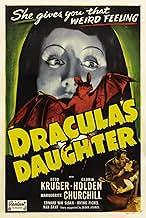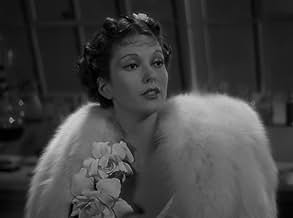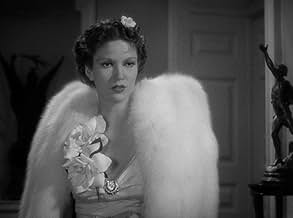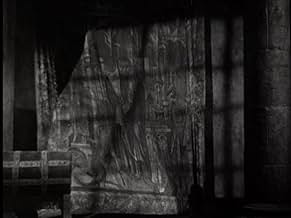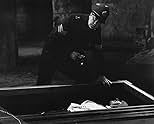AVALIAÇÃO DA IMDb
6,3/10
8,7 mil
SUA AVALIAÇÃO
Adicionar um enredo no seu idiomaWhen Countess Marya Zaleska appears in London, mysterious events occur that lead Dr. Von Helsing to believe that the Countess must be a vampire.When Countess Marya Zaleska appears in London, mysterious events occur that lead Dr. Von Helsing to believe that the Countess must be a vampire.When Countess Marya Zaleska appears in London, mysterious events occur that lead Dr. Von Helsing to believe that the Countess must be a vampire.
- Direção
- Roteiristas
- Artistas
- Prêmios
- 1 vitória e 1 indicação no total
Halliwell Hobbes
- Hawkins
- (as Halliwell Hobbs)
Claud Allister
- Sir Aubrey
- (as Claude Allister)
Agnes Anderson
- Elena
- (não creditado)
John Blood
- Bobby
- (não creditado)
David Dunbar
- Motor Bobby
- (não creditado)
Douglas Gordon
- Attendant
- (não creditado)
Owen Gorin
- Groom's Friend
- (não creditado)
Avaliações em destaque
Right after the success of James Whale's "Bride of Frankenstein" (sequel to "Frankenstein", also directed by Whale), Universal Studios decided to make a sequel to their other horror classic film, Tod Browning's "Dracula". Story says that the studio chose Whale again for the project, but his script proved to be too outrageous and subversive that was immediately rejected. It would be Garret Fort, writer of the first "Dracula", who would give flesh to the sequel's screenplay and the experienced director Lambert Hillyer was set to direct it. Like "Bride", this sequel would be focused on a feminine version of the previous monster; it's name, "Dracula's Daughter".
The film starts right after the original ends, with Count Dracula killed by Professor Van Helsing (Edward Van Sloan), however, to his misfortune, he is arrested for the murder of the Transylvanian nobleman and sent to prison as nobody believes he killed an ancient vampire. Realizing that nobody will believe him, Van Helsing asks the help of his dear friend, Dr. Jeffrey Garth (Otto Kruger), a former student of his who has become a prominent psychiatrist. While this events happen, a mysterious woman steals Dracula's body and a new series of murders start, complicating Van Helsing's defense and Garth's investigation. To make things worse, Countess Marya Zaleska (Gloria Holden) arrives and her seductive charms will prove too strong for Garth to resist them.
Unlike "Frankenstein", where there was still material in the source novel to build up a sequel; in "Dracula"'s case things get complicated, as the monster is effectively killed at the end. However, Garret Fort builds up an original story of mystery, horror and even nods to screwball comedy. "Dracula's Daughter"'s themes of betrayal, deception, and the quest for redemption are dark indeed, but Fort manages to add some light-hearted moments that break the suspense in an appropriate manner. Another highlight is that the vampire's sex appeal is enhanced and explored even further than posterior sequels of the now-franchise.
Director Lambert Hillyer had a big experience directing many low-budget films, ranging from westerns to crime dramas, so he was used to work with similar budget constrains. The movie's strength is in its story, and Hillyer knew it, so he keeps a simple yet very effective style that, while nothing too impressive, manages to create the perfect atmosphere for the plot. With nothing more than his well assembled cast and Fort's excellent screenplay, he conceives a film that maybe won't be remembered as influential, but will surely tell its story properly and deliver what it promises.
The cast is vital in this film, as their job is what sets apart the film from other Universal sequels. Otto Kruger is a very good lead actor, with nice looks and an ease for this kind of characters. He has great chemistry with both Gloria Holden and Marguerite Churchill and his performance is one of the film's highlights. Holden portrays the seductive Countess with power and grace in a complicated role as her character is at the same time dominated by a strong sex appeal and a sad and tragic fate. Churchill is superb in her comedy role, and more than mere comic relief, she adds the touch of screwball comedy to the film, giving her energy and charm. And finally, Edward Van Sloan returns as the experienced Van Helsing, and while his role here is more as a spiritual guide to Kruger, he gives another fine performance.
The film's main weakness is without a doubt its low-budget, that not only forced the choice of Hillyer as a director, but it also made it have less production values than other sequels. In a way, this may had been of help, as Hillyer's style bends together perfectly with low-budget projects and also gave the film a look closer to crime melodrama, which was rising in popularity at the time. Sure, Bela Lugosi is definitely missed, but "Dracula's Daughter" makes up for his absence with a witty (and bold for its time) screenplay and a well-assembled cast.
Time has left this film unappreciated, but there is a lot in there to praise, and while nowhere near the best of the Classic Universal Horror films, "Dracula's Daughter" is better than many of the films of its time, and an essential viewing for any fan of Gothic horror. 7/10
The film starts right after the original ends, with Count Dracula killed by Professor Van Helsing (Edward Van Sloan), however, to his misfortune, he is arrested for the murder of the Transylvanian nobleman and sent to prison as nobody believes he killed an ancient vampire. Realizing that nobody will believe him, Van Helsing asks the help of his dear friend, Dr. Jeffrey Garth (Otto Kruger), a former student of his who has become a prominent psychiatrist. While this events happen, a mysterious woman steals Dracula's body and a new series of murders start, complicating Van Helsing's defense and Garth's investigation. To make things worse, Countess Marya Zaleska (Gloria Holden) arrives and her seductive charms will prove too strong for Garth to resist them.
Unlike "Frankenstein", where there was still material in the source novel to build up a sequel; in "Dracula"'s case things get complicated, as the monster is effectively killed at the end. However, Garret Fort builds up an original story of mystery, horror and even nods to screwball comedy. "Dracula's Daughter"'s themes of betrayal, deception, and the quest for redemption are dark indeed, but Fort manages to add some light-hearted moments that break the suspense in an appropriate manner. Another highlight is that the vampire's sex appeal is enhanced and explored even further than posterior sequels of the now-franchise.
Director Lambert Hillyer had a big experience directing many low-budget films, ranging from westerns to crime dramas, so he was used to work with similar budget constrains. The movie's strength is in its story, and Hillyer knew it, so he keeps a simple yet very effective style that, while nothing too impressive, manages to create the perfect atmosphere for the plot. With nothing more than his well assembled cast and Fort's excellent screenplay, he conceives a film that maybe won't be remembered as influential, but will surely tell its story properly and deliver what it promises.
The cast is vital in this film, as their job is what sets apart the film from other Universal sequels. Otto Kruger is a very good lead actor, with nice looks and an ease for this kind of characters. He has great chemistry with both Gloria Holden and Marguerite Churchill and his performance is one of the film's highlights. Holden portrays the seductive Countess with power and grace in a complicated role as her character is at the same time dominated by a strong sex appeal and a sad and tragic fate. Churchill is superb in her comedy role, and more than mere comic relief, she adds the touch of screwball comedy to the film, giving her energy and charm. And finally, Edward Van Sloan returns as the experienced Van Helsing, and while his role here is more as a spiritual guide to Kruger, he gives another fine performance.
The film's main weakness is without a doubt its low-budget, that not only forced the choice of Hillyer as a director, but it also made it have less production values than other sequels. In a way, this may had been of help, as Hillyer's style bends together perfectly with low-budget projects and also gave the film a look closer to crime melodrama, which was rising in popularity at the time. Sure, Bela Lugosi is definitely missed, but "Dracula's Daughter" makes up for his absence with a witty (and bold for its time) screenplay and a well-assembled cast.
Time has left this film unappreciated, but there is a lot in there to praise, and while nowhere near the best of the Classic Universal Horror films, "Dracula's Daughter" is better than many of the films of its time, and an essential viewing for any fan of Gothic horror. 7/10
The best of the Universal Dracula films will always be the one from 1931 with Bela Lugosi, which is one of the best and most iconic Universal Studios horrors. But its follow-ups generally are worth a look; Son of Dracula despite Lon Chaney Jnr's miscast Dracula was much better than expected, being a good-looking film with a lot of atmosphere and at least two scenes among the best of any Universal Studios Gothic horror film but House of Dracula while watchable was disappointing apart from a couple of effective sequences, nice sets and a few good performances but did suffer mainly from having too many ideas and not enough time to explore them.
Dracula's Daughter however is the best of them. Is it as good as the 1931 film? No, but it almost is. Two or three things do bring it down. The humour at the beginning with the cops was incredibly hokey and more overly-silly and misplaced than funny. Otto Kruger is an unappealingly stiff male lead, Garth has some very abrupt decision-making that Kruger overdoes to the point it gets annoying. And while the banter between him and Marguerite Churchill's Janet was very enjoyable and witty there was a little too much of it, it could have taken up less of the film and the film could have focused more on Von Helsing. Personal opinion of course.
On the other hand, Dracula's Daughter has great production values. The costumes and sets are sumptuous and splendidly Gothic and the film's beautifully photographed too. The music score, actually sounding original and not stock, compliments the mood very well and has to be one of the eeriest of any of the music scores in the Universal horrors. Dracula's Daughter is wittily scripted as just as I appreciated the film noir-ish-like direction of Son of Dracula I also appreciated the sombre, moody approach that the direction in Dracula's daughter took. The story, apart from the hokey start, is fun and atmospheric, there is a real eeriness but a poignant edge too. Of individual scenes the scene with the Countess Zaleska and Lilli is infamous and for a reason. Apart from Kruger the acting is good, Marguerite Churchill is amusing and Edward Van Sloan once again brings class to Von Helsing but the most memorable turns are from Irving Pichel and especially Gloria Holden. Pichel is effectively sinister especially towards the end while Holden is unforgettable in the title, subtly creepy but somewhat tragic.
All in all, not as good as the 1931 film but of the Dracula sequels Universal made to me Dracula's Daughter's the best one. 8/10 Bethany Cox
Dracula's Daughter however is the best of them. Is it as good as the 1931 film? No, but it almost is. Two or three things do bring it down. The humour at the beginning with the cops was incredibly hokey and more overly-silly and misplaced than funny. Otto Kruger is an unappealingly stiff male lead, Garth has some very abrupt decision-making that Kruger overdoes to the point it gets annoying. And while the banter between him and Marguerite Churchill's Janet was very enjoyable and witty there was a little too much of it, it could have taken up less of the film and the film could have focused more on Von Helsing. Personal opinion of course.
On the other hand, Dracula's Daughter has great production values. The costumes and sets are sumptuous and splendidly Gothic and the film's beautifully photographed too. The music score, actually sounding original and not stock, compliments the mood very well and has to be one of the eeriest of any of the music scores in the Universal horrors. Dracula's Daughter is wittily scripted as just as I appreciated the film noir-ish-like direction of Son of Dracula I also appreciated the sombre, moody approach that the direction in Dracula's daughter took. The story, apart from the hokey start, is fun and atmospheric, there is a real eeriness but a poignant edge too. Of individual scenes the scene with the Countess Zaleska and Lilli is infamous and for a reason. Apart from Kruger the acting is good, Marguerite Churchill is amusing and Edward Van Sloan once again brings class to Von Helsing but the most memorable turns are from Irving Pichel and especially Gloria Holden. Pichel is effectively sinister especially towards the end while Holden is unforgettable in the title, subtly creepy but somewhat tragic.
All in all, not as good as the 1931 film but of the Dracula sequels Universal made to me Dracula's Daughter's the best one. 8/10 Bethany Cox
Dracula's Daughter is a Universal monster movie made in 1936, picking up where the original Dracula left off. The opening scene has the police discovering that Dr. Van Helsing has just staked Count Dracula. The plot moves quickly on with two strands, one involving a friend of Van Helsing.....Dr. Jeffrey Garth....in pursuit of defending his colleague and the other strand involving the daughter of Dracula....Marya Zaleska....in London trying to rid herself of her family curse finding it an impossible task. The two strands finally meet and intertwine. The movie has some rather obvious shortcomings. One is Otto Kruger, whom is irritating as one reviewer earlier stated. He is lacklustre and pompous in a very hollow way. The film also lacks a credible story line and is given in to the temptation of assuming a great deal from the viewer. However, Dracula's Daughter still is a very enjoyable film. It has wonderful atmosphere, grand sets(particularly when in Translyvania), and a good performance from Holden as the lead and Van Sloan in a reprise of his role as the good doctor Van Helsing. Above all it has a wonderfully eerie, disturbing, and macabre performance from Irving Pinchel as the servant of the female vampire. He is her reminder of what she is, and he never lets her forget that curse which forces her to live by night and sleep by day.
Dracula's Daughter begins right where Tod Browning's Dracula left off, and ironically sees vampire slayer, Van Helsing in trouble with the law for the murder of Count Dracula. This follow up doesn't have the same quality feel about it that the original had, and it seems clear that this was always meant to be very much a 'B' movie picture. But at the same time, its lots of fun to watch; and the fact that it begins straight after the ending of the Bela Lugosi film ensures that it's credible as far as Universal's series is concerned, and that fact will also give many fans of the original film a good reason to see it. The plot starts properly when a young woman turns up at the police station, wanting to know if Count Dracula really is dead. We then follow her as she tries to undo her family curse, aided by psychiatrist Dr. Jeffrey Garth. However, around the same time that this is going on; corpses begin appearing around London, and jailed Van Helsing is convinced that vampires are roaming the streets of London again.
Unfortunately, this follow up doesn't feature the bloodsucking demon of the first film, and as the title suggests; follows his daughter instead. Gloria Holden excels in the title role as the daughter of Dracula. She's seductively sexy and has a definite air of understated evil about her at the same time. The rest of the support cast back her up excellently, and while nobody other than the title character is a real standout; the ensemble comes together nicely. Atmosphere is obviously a big thing here, and director Lambert Hillyer does a great job of photographing the locations, and ensures that the film benefits from a malevolent aura at all times. The story is obviously nowhere near as great as the original, which was based on the novel by Bram Stoker; but it's good enough. Writing a follow-up to Dracula can't be easy, and while the plot isn't too engaging, it's always at least interesting. There's an underscore of black humour hanging around just behind the central plot, and overall I would say this is a worthy sequel, although it's not a patch on the original film.
Unfortunately, this follow up doesn't feature the bloodsucking demon of the first film, and as the title suggests; follows his daughter instead. Gloria Holden excels in the title role as the daughter of Dracula. She's seductively sexy and has a definite air of understated evil about her at the same time. The rest of the support cast back her up excellently, and while nobody other than the title character is a real standout; the ensemble comes together nicely. Atmosphere is obviously a big thing here, and director Lambert Hillyer does a great job of photographing the locations, and ensures that the film benefits from a malevolent aura at all times. The story is obviously nowhere near as great as the original, which was based on the novel by Bram Stoker; but it's good enough. Writing a follow-up to Dracula can't be easy, and while the plot isn't too engaging, it's always at least interesting. There's an underscore of black humour hanging around just behind the central plot, and overall I would say this is a worthy sequel, although it's not a patch on the original film.
One of Universal's most unusual horror films and a more than worthy successor to Lugosi's Dracula (1931) - although I wouldn't go so far as to say it's better: BRIDE OF FRANKENSTEIN (1935) it ain't! The film's approach is very different to its predecessor - despite having the same scriptwriter, Garrett Fort - as it presents the vampire lady of the title as a somewhat tragic figure rather than a mere spook, and Gloria Holden has both the exotic looks and acting talent for the role. Perhaps to make up for Lugosi's absence, the script features a creepy vampire acolyte in the figure of Irving Pichel: fine actor though he is, I think the make-up department went overboard in trying to make him look menacing!
Otto Kruger and Marguerite Churchill are two of the oddest, and yet most likable, leads in a Universal horror film: not only their age difference is immediately apparent, as is their obvious intelligence, but they share a love/hate relationship all through the picture which is both fresh and endearing. The supporting cast is filled with stalwarts of the genre: first and foremost, naturally, is Edward Van Sloan who reprises his seminal Van Helsing characterization as if he had never been away; Billy Bevan, Halliwell Hobbes and E.E. Clive as coppers of different ranks; Gilbert Emery as the unavoidable incredulous Scotland Yard official; Edgar Norton as his 'fresh' butler; and, adding to the fun, there's also Claud Allister as an upper-class nitwit and famed columnist Hedda Hopper as a gossiping socialite. Nan Grey, later female lead of THE INVISIBLE MAN RETURNS (1940), appears briefly as one of Dracula's victims in what remains perhaps the film's most discussed scene (due to its lesbian overtones). Unlike the original, this sequel is briskly paced and the vampire's demise is not anti-climactic.
Otto Kruger and Marguerite Churchill are two of the oddest, and yet most likable, leads in a Universal horror film: not only their age difference is immediately apparent, as is their obvious intelligence, but they share a love/hate relationship all through the picture which is both fresh and endearing. The supporting cast is filled with stalwarts of the genre: first and foremost, naturally, is Edward Van Sloan who reprises his seminal Van Helsing characterization as if he had never been away; Billy Bevan, Halliwell Hobbes and E.E. Clive as coppers of different ranks; Gilbert Emery as the unavoidable incredulous Scotland Yard official; Edgar Norton as his 'fresh' butler; and, adding to the fun, there's also Claud Allister as an upper-class nitwit and famed columnist Hedda Hopper as a gossiping socialite. Nan Grey, later female lead of THE INVISIBLE MAN RETURNS (1940), appears briefly as one of Dracula's victims in what remains perhaps the film's most discussed scene (due to its lesbian overtones). Unlike the original, this sequel is briskly paced and the vampire's demise is not anti-climactic.
Você sabia?
- CuriosidadesOriginally, Universal wanted to make a sequel based on Bram Stoker's short story 'Dracula's Guest' and negotiated with Stoker's widow Florence. During the talks between the two, it was discovered that Bram Stoker had not complied with one requirement of the U.S Copyright office with his novel 'Dracula', which rendered it public domain in the United States. Because Florence wanted more creative control over the sequel, and Bela Lugosi wanted more money to reprise the role of Count Dracula, Universal instead hired John L. Balderston to write a new story.
- Erros de gravaçãoAlthough the film takes place mostly in London, telephones consistently ring one ring at a time, whereas British phones have always used a double ring.
- Citações
Lady Esme Hammond: Sherry, Marya?
Countess Marya Zaleska: Thank you, I never drink... wine.
- ConexõesFeatured in Shock Theater: Dracula's Daughter (1959)
Principais escolhas
Faça login para avaliar e ver a lista de recomendações personalizadas
Detalhes
- Data de lançamento
- País de origem
- Centrais de atendimento oficiais
- Idiomas
- Também conhecido como
- La hija de Drácula
- Locações de filme
- Empresa de produção
- Consulte mais créditos da empresa na IMDbPro
- Tempo de duração1 hora 11 minutos
- Cor
- Proporção
- 1.37 : 1
Contribua para esta página
Sugerir uma alteração ou adicionar conteúdo ausente




